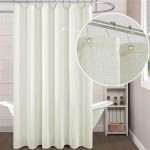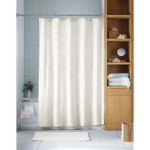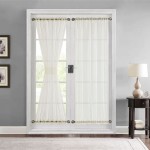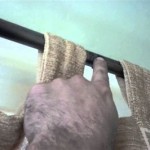Curtain Hooks for Vertical Blinds: An In-Depth Guide
Vertical blinds, recognized for their versatility and functionality in light control and privacy, are often incorporated into a variety of architectural designs. A critical, yet frequently overlooked, component of these blinds is the curtain hook. These small but essential accessories play a vital role in connecting the fabric or vinyl vanes to the headrail, enabling the smooth and efficient operation of the blind system. Understanding the nuances of these hooks, their types, and proper installation is crucial for maintaining the performance and longevity of vertical blinds.
This article will provide a comprehensive overview of curtain hooks designed specifically for vertical blinds. We will delve into the various types available, the materials used in their construction, and the considerations involved in selecting the appropriate hooks for different blind systems. Furthermore, we will explore the installation and maintenance procedures required to ensure optimal performance and prevent common issues such as breakage and detachment.
Understanding the Function of Vertical Blind Curtain Hooks
The primary function of a curtain hook in a vertical blind system is to securely attach the individual vanes, also known as slats, to the carrier clips located within the headrail. The headrail is the horizontal track that houses the mechanism responsible for tilting and traversing the vanes. The carrier clips are small components that move along the track, allowing the vanes to be rotated for light control or drawn completely open for unobstructed views. The curtain hooks serve as the intermediary connection, ensuring that the vanes move in unison with the carrier clips.
Without properly functioning curtain hooks, the vanes can become detached, misaligned, or difficult to operate. This not only compromises the aesthetic appeal of the blinds but also affects their ability to effectively block light and provide privacy. Therefore, selecting and maintaining appropriate curtain hooks is paramount to the overall performance and lifespan of the vertical blind system. The hooks must be durable enough to withstand the constant motion and weight of the vanes, while also providing a secure and reliable connection to the carrier clips.
Furthermore, the design of the curtain hook influences the ease of installation and replacement. Hooks that are easy to install and remove simplify maintenance and repair, reducing the downtime required to address any issues with the blinds. The design should also ensure that the hook does not interfere with the smooth movement of the carrier clips along the headrail, preventing jamming or other operational problems.
Types of Curtain Hooks Used in Vertical Blinds
A variety of curtain hook designs exist, each tailored to specific types of vertical blind systems and vane materials. The selection of the appropriate hook depends on factors such as the weight and thickness of the vanes, the design of the headrail and carrier clips, and the desired aesthetic appearance. Common types of curtain hooks include:
- Standard Plastic Hooks: These are the most common type of curtain hooks used in vertical blinds. They are typically made from molded plastic and feature a simple design that allows for easy insertion into the vane and attachment to the carrier clip. Standard plastic hooks are relatively inexpensive and suitable for lightweight fabric or vinyl vanes. However, they may be prone to breakage under heavy loads or with prolonged use.
- Metal Hooks: Metal hooks offer greater durability and strength compared to their plastic counterparts. They are often constructed from materials such as steel or aluminum and are designed to withstand heavier vanes and more frequent use. Metal hooks are typically used in commercial settings or in residential installations where increased durability is required. These hooks provide a more secure connection between the vane and the carrier clip, minimizing the risk of detachment or misalignment.
- Sewn-In Fabric Hooks: These hooks are integrated directly into the top edge of the fabric vane. They consist of a fabric loop or pocket that is sewn into the vane and designed to accommodate the carrier clip. Sewn-in fabric hooks provide a clean and seamless appearance, as they are not visible from the front of the blind. This type of hook is typically used in higher-end fabric vertical blind systems.
- Snap-On Hooks: Snap-on hooks feature a two-piece design that allows for easy attachment and removal. One piece is attached to the vane, while the other piece clips onto the carrier. Snap-on hooks are particularly useful for blinds that require frequent vane replacement or cleaning. They offer a convenient and efficient way to detach and reattach the vanes without damaging the fabric or vinyl.
- Specialty Hooks: In addition to the standard types of curtain hooks, specialty hooks are available for specific blind systems or vane designs. These hooks may feature unique shapes, sizes, or materials to accommodate particular requirements. Examples include hooks designed for curved vanes, hooks with adjustable lengths, and hooks made from specialized polymers with enhanced durability or resistance to UV light.
When selecting curtain hooks, it is essential to consider the specific requirements of the vertical blind system and the characteristics of the vanes. Choosing the wrong type of hook can lead to performance issues, premature wear, and reduced lifespan of the blinds. Consulting with a blind professional or manufacturer can help ensure that the appropriate hooks are selected for a particular application.
Factors to Consider When Choosing Vertical Blind Curtain Hooks
Selecting the right curtain hooks for vertical blinds is a critical step in ensuring the longevity and proper functioning of the window treatment. Several factors should be carefully considered during the selection process:
- Vane Weight and Material: The weight and material of the vertical blind vanes directly influence the type of curtain hook required. Heavier vanes, such as those made from thick fabrics or vinyl, demand stronger and more durable hooks, like metal options. Lighter vanes, on the other hand, may be adequately supported by standard plastic hooks. The material composition of the vane also plays a role; certain fabrics may require hooks that are specifically designed to prevent snagging or tearing.
- Headrail Compatibility: The design and configuration of the headrail and carrier system are crucial factors. The curtain hooks must be compatible with the specific type of carrier clips used in the headrail. Incompatible hooks may not properly attach to the clips, leading to instability and potential detachment of the vanes. It is essential to verify that the dimensions and shape of the hook are suitable for the carrier clip design.
- Durability and Longevity: The durability of the curtain hooks directly impacts the lifespan of the vertical blinds. Hooks made from high-quality materials, such as metal or reinforced plastic, are more resistant to wear and tear, breakage, and deformation. In environments with high humidity or exposure to direct sunlight, it's vital to choose hooks that are resistant to corrosion and UV degradation.
- Ease of Installation and Replacement: The design of the curtain hook should facilitate easy installation and replacement. Hooks that are difficult to install or remove can make routine maintenance and repairs more time-consuming and challenging. Snap-on hooks or hooks with simple insertion mechanisms can be particularly advantageous for blinds that require frequent vane replacement or cleaning.
- Aesthetic Considerations: While functionality is paramount, the aesthetic appearance of the curtain hooks should also be considered. Hooks that are visible from the front of the blind should complement the overall design and color scheme of the window treatment. Sewn-in fabric hooks offer a more discreet and seamless look, as they are concealed within the vane.
- Cost: Cost is always a consideration. While metal hooks generally offer greater durability, they also come at a higher price point than plastic hooks. Evaluating the long-term value and considering the frequency of replacement can help determine the most cost-effective option. It's often more economical to invest in durable hooks that will last longer than to repeatedly replace cheaper, less durable ones.
By carefully evaluating these factors, users can make informed decisions about the selection of curtain hooks for their vertical blinds. Choosing the right hooks ensures the optimal performance, longevity, and aesthetic appeal of the window treatment.
Installation and Maintenance of Vertical Blind Curtain Hooks
Proper installation and regular maintenance of curtain hooks are essential for maximizing the performance and lifespan of vertical blinds. The installation process typically involves attaching the hooks to the vanes and then connecting the vanes to the carrier clips within the headrail. The specific steps may vary depending on the type of hook and the design of the blind system.
To install standard plastic or metal hooks, carefully insert the hook into the designated slot or hole at the top of the vane. Ensure that the hook is securely seated and that it aligns properly with the carrier clip. Next, gently slide the hook onto the carrier clip, making sure that it is fully engaged. Repeat this process for each vane, ensuring that all vanes are properly attached and aligned.
For sewn-in fabric hooks, simply slide the carrier clip through the fabric loop or pocket at the top of the vane. Ensure that the clip is centered within the loop and that the vane hangs straight. For snap-on hooks, attach one piece of the hook to the vane and the other piece to the carrier clip. Then, snap the two pieces together, ensuring that they are securely connected.
Once the vanes are installed, operate the blinds to ensure that they move smoothly and evenly. Check for any signs of misalignment or detachment. If any issues are detected, readjust the hooks or replace any damaged hooks.
Regular maintenance of curtain hooks includes inspecting them periodically for signs of wear, damage, or detachment. Replace any broken or worn hooks immediately to prevent further damage to the blinds. Clean the hooks regularly to remove dust, dirt, and debris. Use a soft cloth or brush to gently wipe the hooks clean. Avoid using harsh chemicals or abrasive cleaners, as they can damage the hooks. Lubricating the carrier clips within the headrail can further ensure smooth operation.
By following these installation and maintenance procedures, users can ensure that their vertical blind curtain hooks function properly and that their blinds provide years of reliable service.

2 Pcs Venetian Blind Accessories Replacement Vertical Wand Shower Curtain Hooks Drapes Window Blinds

How To Conceal Vertical Blinds With Curtains Engineer Your Space

Simple Ways To Hang Curtains Over Vertical Blinds 13 Steps

Vertical Curtain Slides Heavy Duty Hooks Blind Pulley Inserts Replacement Parts

24pcs Curtain Hooks Vertical Blind Wand Rod Tip Hook

20 Pcs Curtain Hook Vertical Blinds Repair Kit Decor Window Curtains Fixation Hooks Cord Safety

How Can I Hook Curtains To Vertical Blinds Home Improvement Stack Exchange

4 Pcs Curtain Hook Wand Vertical Blinds Replacement Parts Metal Tilt

Simple Ways To Hang Curtains Over Vertical Blinds 13 Steps

How To Hang Curtains Conceal Vertical Blinds Engineer Your Space








